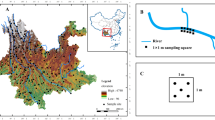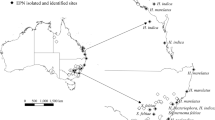Abstract
Nematode-trapping fungi, a monophyletic lineage within the Orbiliales (Ascomycota), use specialized structures to capture and consume nematodes in soil, leaf litter, and other substrates. These fungi have been studied both because of their unique predatory life history and because they are potential control agents of important plant- and animal-parasitic nematodes. Ecological studies of nematode-trapping fungi have primarily used culture-based methods, but molecular detection techniques are now available and should be useful for studying this group. We developed Orbiliales-specific PCR primers for the ITS and 28s rDNA to directly detect nematode-trapping fungi without culturing and also to screen fungal isolates for phylogenetic placement in the Orbiliales. We used these primers to selectively amplify, clone, and sequence Orbiliales DNA extracted from soil, litter, and wood, and we compared the results of molecular detection with those obtained using a culture-based method. Of the eight species of nematode-trapping Orbiliales detected with the culture-based assay, only three were detected with PCR. The molecular assay, however, detected 18 species of uncultured Orbiliales, many of which are closely related to nematode-trapping fungi and fungal parasites of nematode eggs. Our results suggest that the combined use of Orbiliales-specific primers and culture-based techniques may benefit future studies of nematophagous fungi.




Similar content being viewed by others
References
Abiko S, Saikawa M, Ratnawati (2005) Capture of mites and rotifers by four strains of Dactylella gephyropaga known as a nematophagous hyphomycete. Mycoscience 46:22–26
Ahrén D, Faedo M, Rajastiekar B, Tunlid A (2004) Low genetic diversity among isolates of the nematode-trapping fungus Duddingtonia flagrans: evidence for recent worldwide dispersion from a single common ancestor. Mycol Res 108:1205–1214
Ahrén D, Ursing B, Tunlid A (1998) Phylogeny of nematode-trapping fungi based on 18S rDNA sequences. FEMS Microbiol Lett 158:179–184
Allen TR, Millar T, Berch SM, Berbee ML (2003) Culturing and direct DNA extraction find different fungi from the same ericoid mycorrhizal roots. New Phytol 160:255–272
Anderson IC, Campbell CD, Prosser JI (2003) Potential bias of fungal 18s rDNA and internal transcribed spacer polymerase chain reaction primers for estimating fungal biodiversity in soil. Environ Microbiol 5:36–47
Arnold EA, Henk DA, Eells RL, Lutzoni F, Vilgalys R (2007) Diversity and phylogenetic affinities of foliar fungal endophytes in loblolly pine inferred by culturing and environmental PCR. Mycologia 99:185–206
Bailey F, Gray NF (1989) The comparison of isolation techniques for nematophagous fungi from soil. Ann Appl Bio 114:125–132
Barron GL (1977) The nematode-destroying fungi. Canadian Biological, Guelph, pp 1–140
Barron GL (1990) A new predatory hyphomycete capturing copepods. Can J Bot 68:691–696
Bidartondo MI, Gardes M (2005) Fungal diversity in molecular terms: profiling, identification, and quantification from the environment. In: Dighton JJ, White F, Oudemans P (eds) The Fungal Community, 3rd edition. CRC, New York, pp 215–239
Borneman J, Hartin RJ (2000) PCR primers that amplify fungal rRNA genes from environmental samples. Appl Environ Microbiol 6:4356–4360
Chen J, Xu L-L, Liu B, Liu X-Z (2007) Taxonomy of the Dactylella complex and Vermispora I. Generic concepts based on morphology and ITS sequence data. Fungal Divers 26:73–83
Chen J, Xu L-L, Liu B, Liu X-Z (2007) Taxonomy of the Dactylella complex and Vermispora III. A new genus Brachyphoris and revision of Vermispora. Fungal Divers 26:127–142
Chenna R, Sugawara H, Koide T, Lopez R, Gibson TJ, Higgins DG, Thompson JD (2003) Multiple sequence alignment with the Clustal series of programs. Nucleic Acids Res 31:3497–3500
Dixon SM (1952) Predacious fungi from rotten wood. Trans Br Mycol Soc 35:144–148
Drechsler C (1934) Organs of capture in some fungi preying on nematodes. Mycologia 26:135–144
Drechsler C (1936) A fusarium-like species of Dactylella capturing and consuming testaceous rhizopods. J Wash Acad Sci 26:397–404
Drechsler C (1943) A new nematode-capturing Dactylella and several related hyphomycetes. Mycologia 35:339–362
Drechsler C (1944) A species of Arthrobotrys that captures springtails. Mycologia 36:382–399
Drechsler C (1952) Another nematode-strangulating Dactylella and some related hyphomycetes. Mycologia 4:533–556
Drechsler C (1962) Two additional species of Dactylella parasitic on Pythium oospores. Sydowia 15:94–96
Drechsler C (1963) A slender-spored Dactylella parasitic on Pythium oospores. Phytopathology 53:993–994
Duddington CL (1951) The ecology of predacious fungi I. Preliminary survey. Trans Br Mycol Soc 34:322–331
Gardes M, Bruns TD (1993) ITS primers with enhanced specificity for basidiomycetes—application to the identification of mycorrhizae and rusts. Mol Ecol 2:113–118
Gray NF (1983) Ecology of nematophagous fungi: Panagrellus redivivus as the target organism. Plant Soil 73:293–297
Gray NF (1984) Ecology of nematophagous fungi: Methods of collection, isolation and maintenance of predatory and endoparasitic fungi. Mycopathologia 86:143–153
Gray NF (1985) Ecology of nematophagous fungi: Effect of soil moisture, organic matter, pH and nematode density on distribution. Soil Biol and Biochem 17:499–507
Hagedorn G, Scholler M (1999) A reevaluation of predatory orbiliaceous fungi I Phylogenetic analysis using rDNA sequence data. Sydowia 51:27–48
Hopple J, Vilgayls R (1994) Phylogenetic relationships among coprinoid taxa and allies based on data from restriction site mapping of nuclear rDNA. Mycologia 86:96–107
Jaffee BA, Tedford EC, Muldoon AE (1993) Tests for density-dependent parasitism of nematodes by trapping and endoparasitic fungi. Biol Control 3:329–336
Jaffee BA, Strong DR, Muldoon AE (1996) Nematode-trapping fungi of a natural shrubland: Tests for food chain involvement. Mycologia 88:554–564
Jaffee BA, Muldoon AE (1997) Suppression of the root-knot nematode Meloidogyne javanica by alginate pellets containing the nematophagous fungi Hirsutella rhossiliensis, Monacrosporium cionopagum, and M. ellipsosporum. Biocontrol Sci Technol 7:203–217
Jaffee BA (1998) Susceptibility of a cyst and a root-knot nematode to three nematode-trapping fungi. Fundam Appl Nematol 21:695–703
Jaffee BA, Barstow JL, Strong DR (2007) Suppression of nematodes in a coastal grassland soil. Biol Fertil Soils 44:19–26
Juniper AJ (1957) Dung as a source of predacious fungi. Trans Br Mycol Soc 40:346–348
Li SD, Miao ZQ, Zhang YH, Liu X-Z (2003) Monacrosporium janus sp nov, a new nematode-trapping hyphomycete parasitizing sclerotia and hyphae of Sclerotinia sclerotium. Mycol Res 107:888–894
Li Y, Hyde KD, Jeewon R, Cai L, Vijaykrishna D, Zhang KQ (2005) Phylogenetics and evolution of nematode-trapping fungi (Orbiliales) estimated from nuclear and protein coding genes. Mycologia 97:1034–1046
Linford MP, Yap F, Oliveira JM (1938) Reduction of soil populations of the root-knot nematode during decomposition of organic matter. Soil Sci 45:127–141
Liou GY, Tzean SS (1997) Phylogeny of the genus Arthrobotrys and allied nematode-trapping fungi based on rDNA sequences. Mycologia 89:876–884
Liu X-Z, Gao RH, Zhang KQ, Cao L (1996) Dactylella tenuifusaria sp nov, a rhizopod-capturing hyphomycete. Mycol Res 100:236–238
Lynch MDJ, Thorn RG (2006) Diversity of basidiomycetes in Michigan agricultural soils. Appl Environ Microbiol 72:7050–7056
Maddison WP, Maddison DR (2006) Mesquite: A modular system for evolutionary analysis, Version 1.11. http://mesquiteprojectorg
Martin D, Rybicki E (2000) RDP: detection of recombination amongst aligned sequences. Bioinformatics 16:562–563
Meyer SLF, Carta LK, Rehner SA (2005) Morphological variability and molecular phylogeny of the nematophagous fungus Monacrosporium drechsleri. Mycologia 97:405–415
Morton CO, Hirsch PR, Kerry BR (2004) Infection of plant-parasitic nematodes by nematophagous fungi—a review of the application of molecular biology to understand infection processes and to improve biological control. Nematology 6:161–170
O’Brien HE, Parrent JL, Jackson JA, Moncalvo J-M, Vilgalys R (2005) Fungal community analysis by large-scale sequencing of environmental samples. Appl Environ Microbiol 71:5544–5550
Olatinwo R, Yin B, Becker JO, Borneman J (2006a) Suppression of the plant-parasitic nematode Heterodera schachtii by the fungus Dactylella oviparasitica. Phytopathology 96:111–114
Olatinwo R, Borneman J, Becker JO (2006b) Induction of beet-cyst nematode suppressiveness by the fungi Dactylella oviparasitica and Fusarium oxysporum in field microplots. Phytopathology 96:855–859
Olsson S, Persson Y (1994) Transfer of phosphorus from Rhizoctonia solani to the mycoparasite Arthrobotrys oligospora. Mycol Res 98:1065–1068
Persson Y, Erland S, Jansson HB (1996) Identification of the nematode-trapping fungi using RFLP analysis of the PCR-amplified ITS region of ribosomal DNA. Mycol Res 100:531–534
Pfister DH (1994) Orbilia fimicola, a nematophagous discomycete and its Arthrobotrys anamorph. Mycologia 86:451–453
Pfister DH, Liftik ME (1995) Two Arthrobotrys anamorphs from Orbilia auricolor. Mycologia 87:684–688
Pfister DH (1997) Castor, Pollux, and life histories of fungi. Mycologia 89:1–23
Rozen S, Skaletsky HJ (2000) Primer3 on the WWW for general users and for biologist programmers. In: Krawetz S, Misener S (eds) Bioinformatics Methods and Protocols: Methods in Molecular Biology. Humana, Totowa, pp 365–386
Schadt CW, Martin AP, Lipson DA, Schmidt SK (2003) Seasonal dynamics of previously unknown fungal lineages in tundra soils. Science 301:1359–1361
Scholler M, Hagedorn G, Rubner A (1999) A reevaluation of predatory orbiliaceous fungi II. A new generic concept. Sydowia 51:89–113
Smith ME, Douhan GW, Rizzo DM (2007) Ectomycorrhizal community structure in a xeric Quercus woodland based on rDNA sequence analysis of sporocarps and pooled roots. New Phytol 174:847–863
Stirling GR, Mankau R (1978) Dactylella oviparasitica, a new fungal parasite of Meloidogyne eggs. Mycologia 70:774–783
Stirling GR, Mankau R (1979) Mode of parasitism of Meloidogyne and other nematode eggs by Dactylella oviparasitica. J Nematol 11:283–288
Stirling GR, McKenry MV, Mankau R (1979) Biological control of root-knot nematodes (Meloidogyne spp) on peach. Phytopathology 69:806–809
Swofford DL (2001) PAUP*: Phylogenetic analysis using parsimony (*and other methods), Version 4.0b10. Sinauer, Sunderland, MA
Tzean SS, Estey RH (1978) Nematode-trapping fungi as mycopathogens. Phytopathology 68:1266–1270
Vandenkoornhuyse P, Baldauf SL, Leyval C, Straczek J, Young JPW (2002) Extensive fungal diversity in plant roots. Science 295:2051
White TJ, Bruns TD, Lee S, Taylor J (1990) Amplification and direct sequencing of fungal ribosomal RNA genes for phylogenetics. In: Innis MA, Gelfand DH, Sninsky JJ, White TJ (eds) PCR Protocols: A guide to methods and applications. Academic, San Diego, pp 315–322
Wolstrup J (1996) Towards a practical biological control of parasitic nematodes in domestic animals. J Nematol 28:129–132
Yang Y, Yang E, An Z, Liu Z (2007) Evolution of nemtode-trapping cells of predatory fungi of the Orbiliaceae based on evidence from rRNA-encoding DNA and multiprotein sequences. PNAS 104:8379–8384
Acknowledgements
The authors thank Ole Becker and James Borneman for providing cultures of Brachyphoris oviparasitica for 28s sequencing. David M. Rizzo generously provided laboratory space and equipment. UC Bodega Marine Laboratory and Reserve provided a travel grant for B. Jaffee. Antonio Izzo provided valuable advice during primer development. We thank Donald Pfister and two anonymous reviewers for useful comments on previous drafts.
Author information
Authors and Affiliations
Corresponding author
Rights and permissions
About this article
Cite this article
Smith, M.E., Jaffee, B.A. PCR Primers with Enhanced Specificity for Nematode-Trapping Fungi (Orbiliales). Microb Ecol 58, 117–128 (2009). https://doi.org/10.1007/s00248-008-9453-0
Received:
Accepted:
Published:
Issue Date:
DOI: https://doi.org/10.1007/s00248-008-9453-0




